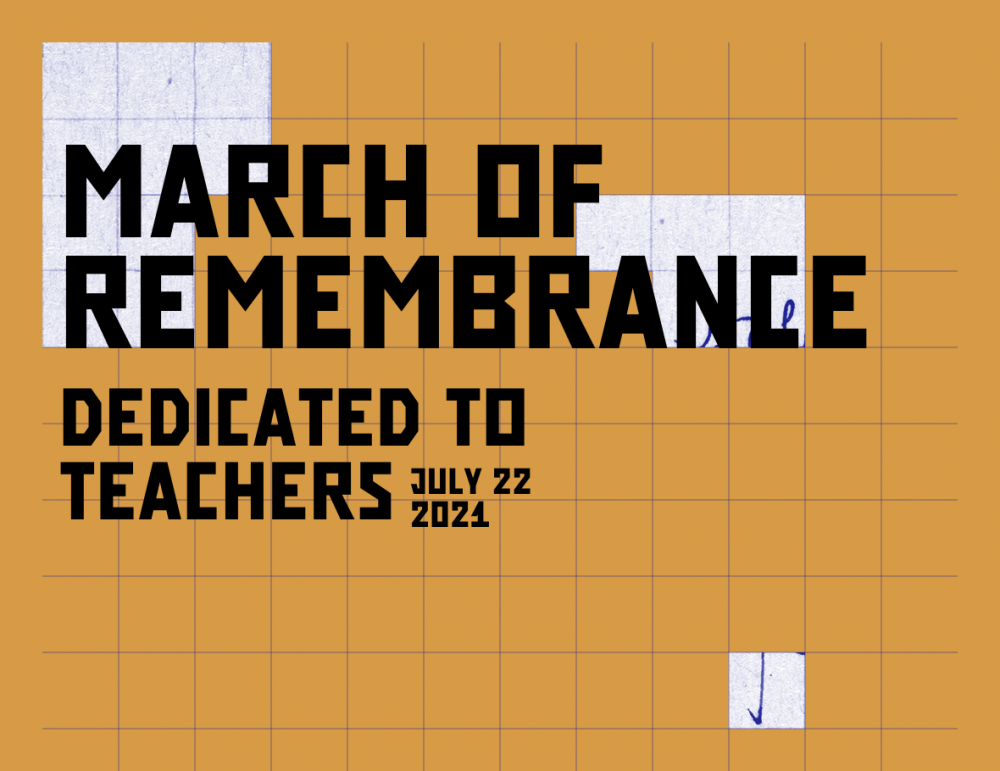- News
- Events
- Oneg Shabbat
- Collections
- Research
- Exhibitions
- Education
- Publishing Department
- Genealogy
- About the Institute
- Bookstore


In The 22nd of July March of Remembrance, for the 10th time now, we commemorate almost 300 thousands Jewish inhabitants of Warsaw who were transported to Treblinka Extermination Camp in the summer of 1942.
This time we are going to specially recall the memory of teachers connected to Oneg Shabbat group, like Abraham Lewin, Emanuel Ringelblum, Eliasz Gutkowski, Izrael Lichtensztajn, or Stefania Szwajger, the manager of girls’ gymnasium at 55 Długa Street and the Polish teachers, who were helping their friends on the other side of ghetto walls.
We will walk together through the symbolic route ‘from death to life’. It will start at 6 pm at Umschlagplatz Memorial, 10 Stawki Street and will end at Stare Nalewki Street, next to Krasiński Garden, where it will be possible to see the art installation “Benches” created especially for this event by the architect Jakub Szczęsny. The installation will be available for public until August 31st.
‘There were many Jewish schools before the WWII in this area, functioning as a part of the public school system, and also a lot of Cheders, Talmud-Toras, Yeshivas and other places providing Jewish religious education’, emphasizes Monika Krawczyk, JHI director.
At the end of this event we will be able to hear the premiere of electro-acoustic piece “Nothing New Has Happened To Us” based on Abraham Lewin’s Diary, casting violin (Maria Sławek), flute (Ania Karpowicz), voice (Marta Grzywacz) and synthesizer (Krzysztof Kozłowski). The piece was prepared by JHI in cooperation with Mieczysław Wajnberg Institute.
Jewish Historical Institute has as well prepared, specifically for this occasion, audiobook of Abraham Lewin’s Diary. In the recording directed by Agnieszka Olsten we will hear the actor Jerzy Radziwiłowicz.
The March’s route: Umschlagplatz Memorial (the corner of Stawki and Dzika Streets) – Stawki Street – Dubois Street – Anielewicz Street – Świętojerska Street – along Krasiński Garden – Stare Nalewki Street.
Volunteers will give out the ribbons containing names of murdered Jews.
Contact:
We encourage you to take photos of your march and share photos on social media with hashtags:
#marszpamięci22lipca #marszpamieci22lipca #wstążkipamięci #wstazkipamieci
Organizer:
the Emanuel Ringelblum Jewish Historical Institute
![ZDK 2021 B ENG.jpg [256.68 KB]](https://www.jhi.pl/storage/image/core_files/2021/3/19/a88920f539c5cd4bc8613880bf0c431d/jpg/jhi/preview/ZDK%202021%20%20B%20ENG.jpg)
The project is financed by Iceland, Liechtenstein and Norway from the EEA Grants and the Polish Ministry of Culture, National Heritage and Sports
Accompanying activities are financed by the Ministry of Culture, National Heritage and Sports.
Partners of the 22nd of July March of Remembrance:
Media Partners:
***
What was the great deportation?
On July 22, 1942, began the so-called liquidation action of the Warsaw Ghetto. According to German announcements, the Jews were to be "relocated to the East". Every day 3,000 to 8,000 people were deported to Treblinka from the Umschlagplatz in Warsaw; 300,000 Jews were led this way during the 46 days of the "operation".
Only a handful of those led onto the trains managed to jump out and saved themselves. Few refugees from Treblinka returned to Warsaw and provided information about gas chambers, but this did not stop the deportation. Jews were murdered not only by gas, many died from lack of air while being transported in overcrowded cattle cars.
A few months later, on April 19, 1943, in the face of the inevitable extermination, the Jews decided to fight for honor and a dignified death, arms in hand. After almost a month of fighting, the uprising was suppressed by the German occupant, and Warsaw was recognized as a city "judenfrei" – free of Jews. Since 2012, the Emanuel Ringelblum Jewish Historical Institute organizes the March of Remembrance on the anniversary of these tragic events, commemorating the largest Jewish community in pre-war Europe.